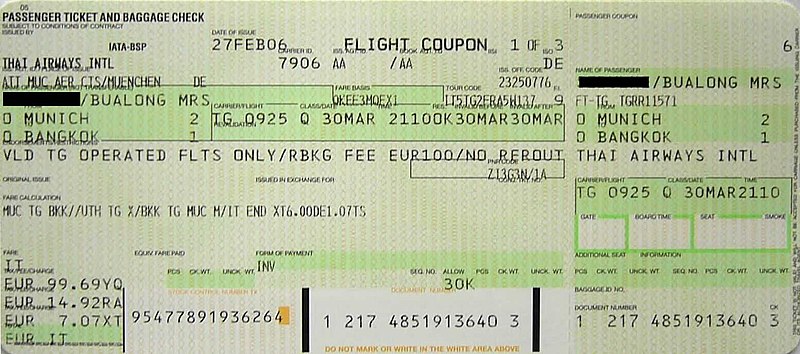Checking in with an E-Ticket
To check in with an e-ticket, the passenger usually comes to the check-in counter and presents the e-ticket itinerary receipt which contains a confirmation or reservation code. In some airports and airlines it's not even necessary to present this document or quote the confirmation code or e-ticket number as the reservation is confirmed solely on the basis of the passenger's identity, which may be proven by a passport or the matching credit card. After confirming the reservation, the passenger checks-in his/her luggage and is given a boarding pass which usually says "Electronic Ticket" or "E-ticket."Replacement of paper tickets
It is now common for a traveler to pay a fee, assessed by the airline company, for a paper ticket. In fact, many airlines no longer issue paper tickets. IATA has announced, that as of June 1, 2008, IATA-member airlines will no longer issue any paper tickets.
A ticket is generally only good on the airline for which it was purchased. However, an airline can endorse the ticket, so that it may be accepted by other airlines, sometimes on standby basis or with a confirmed seat. Usually the ticket is for a specific flight. It is also possible to purchase an 'open' ticket, which allows travel on any flight between the destinations listed on the ticket. The cost for doing this is greater than a ticket for a specific flight. Some tickets are refundable. However, the lower cost tickets are usually not refundable and may carry many additional restrictions. A ticket is made up of one or more flight coupons. In the old paper ticket system, these flight coupons were the actual tickets that were used for travel. One flight coupon was used for each leg of the flight.
The carrier is represented by a standardized 2-letter code. In the example above, Thai Airways is TG. The departure and destination cities are represented by International Air Transport Association airport codes. In the example above, Munich is MUC and Bangkok is BKK. The International Air Transport Association is the standard setting organization.
Only one person can use a ticket. If multiple people are traveling together, the tickets are linked together by the same record locator or reservation number, which are assigned, if the tickets were purchased at the same time. If not, most airlines can connect the tickets together in their reservation systems. This allows all members in a party to be processed in a group, allowing seat assignments to be together (if available at the time of the assignment).








ليست هناك تعليقات:
إرسال تعليق